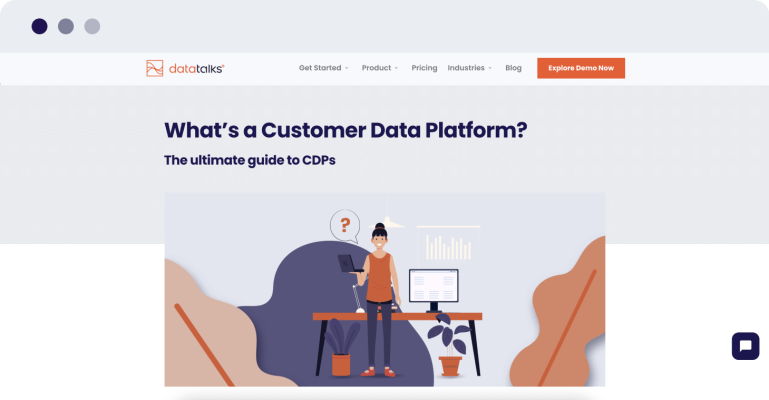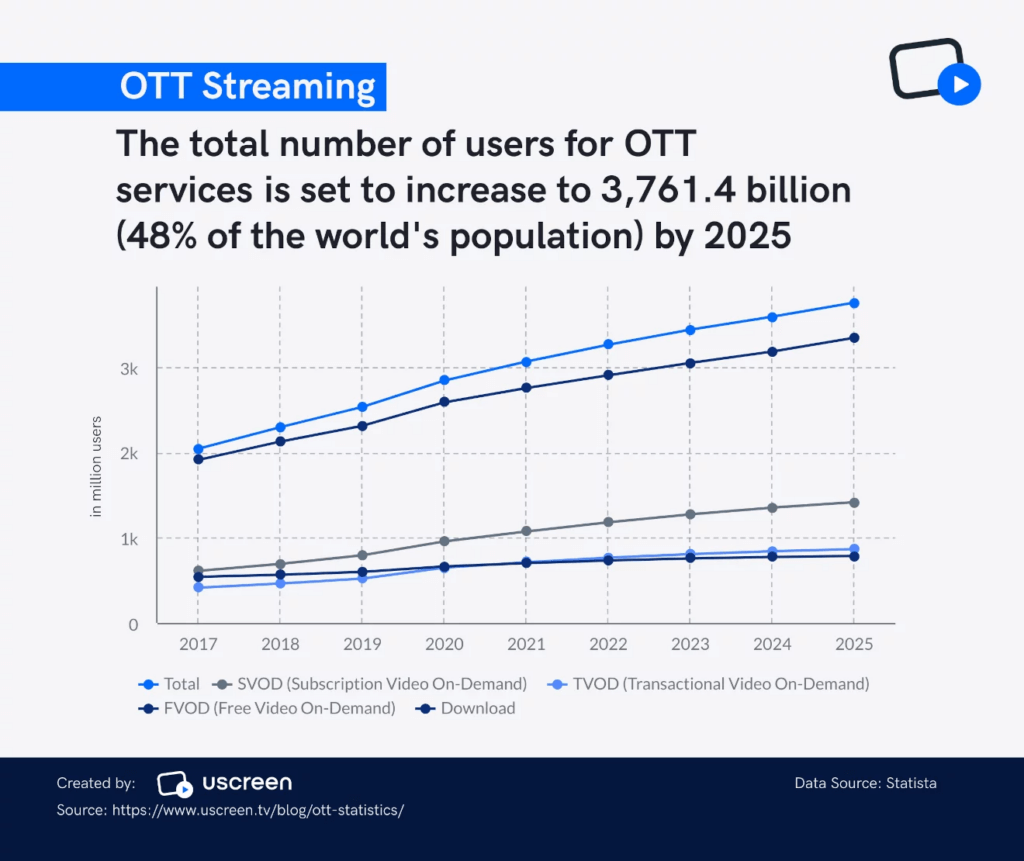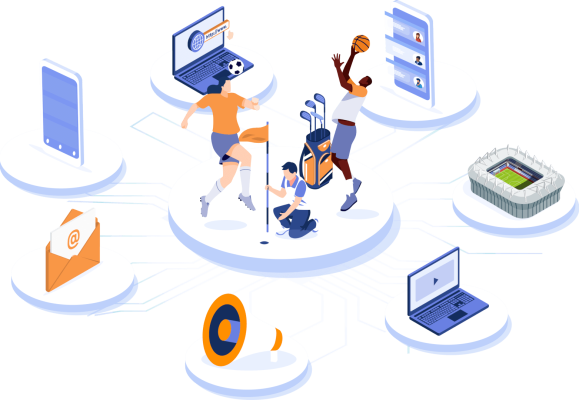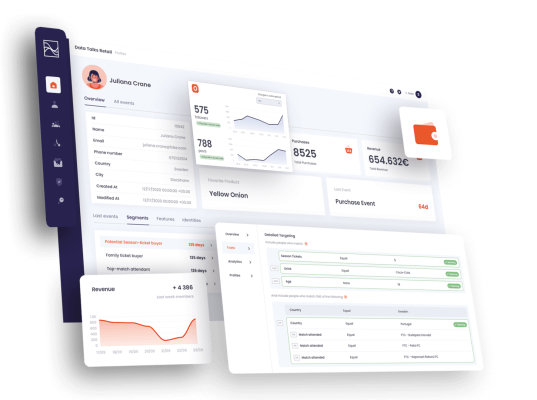
There are many articles and blog posts out there that claim to know what you need. They will tell you that you need to buy this and not that. And that you need to invest in this and not that. But very few justify their claims with enough detail and conviction so you are always very skeptical, right? That’s why we took great care in writing this blog post: “Why sports organizations need a CDP to grow and thrive”.
We understand that your organization has real problems that need to be solved with real and reliable solutions. Additionally, the past couple of years have been very difficult for everyone because of the pandemic. You have probably experienced at least one of the following problems:
- Dwindling revenue
- Decreased fan engagement
- Reduced sponsorship value
- Ineffective marketing strategies
You might also be feeling overwhelmed or discouraged by the lack of results. Or if you are happy with your results, you still want to keep doing better and better, right?
Although it might not seem like there’s much you can do at the moment and that you are at the mercy of too many external factors to get in control, we are here to tell you that there is a reliable solution for you. And that reliable solution to your problems is a sports Customer Data Platform (CDP).
Before we dive right in...
Subscribe to our blog today to ensure that you never miss valuable posts such as this one. We are passionate about helping sports organizations deliver a world-class fan experience, because better fan experience means better business. So why not use this opportunity to the fullest?

Why Sports Organizations need a CDP
In this blog post, we are going to explain exactly why sports organizations need a CDP to grow and thrive in these uncertain times that we live in. And as promised, this post pays great attention to explaining all the necessary details so you can have greater understanding and confidence than ever in this subject matter.
We will only cover 3 reasons why sports organizations need a CDP,but don’t worry if that number seems too low. We fully embrace the principle, “quality over quantity”. Besides, these three points are very rich in insight and knowledge.
So without further ado
Here are the 3 reasons why Sports Organizations need a CDP today
The reasons we advocate so much for a CDP are:

It is the easiest yet most powerful marketing tool out there

You can leverage and create new revenue opportunities with a CDP

While maximizing your marketing spend
Let’s look at each one in greater detail to really make it obvious why sports organizations need a CDP especially nowadays.
Easiest yet most powerful marketing tool out there
The first reason why sports organizations need a CDP is because it is the easiest yet most powerful marketing tool out there. In an ideal world, this is what everything you do would be – easy yet powerful. Easy does not mean that you can do things half-heartedly or that there are no challenges. But rather, that it is time and cost-effective while producing unparalleled results.
In this section, you will find that the explanations we give for what makes a CDP powerful are also in and of themselves proof of why sports organizations need a CDP. Everything is interlinked.
What makes a CDP easy yet powerful?
With a CDP you can:

Collect and store all data in one place
Sports organizations need a CDP for this very reason.
Can you imagine a future where you don’t have to use 10 different software to achieve one goal?
You currently have supporter data stored in:
- Point of Sale (POS) system for food and beverage purchases, for example
- Ticketing system
- Online POS for your merchandise
- If you have an app, you have supporter data stored there too
- Ever used an OTT streaming service such as YouTube, there’s data there too
- Social media platforms such as Facebook, Twitter, and Instagram
- Volunteers and members lists
- Newsletter and mailing lists
- Event sign up sheets
The list goes on and on.
When you have so much data at your disposal, you need to store it all in one place. By doing so, you can get a clearer and fuller picture of the person you would like to interact with.
What happens if you don’t have all this data in one place?
With a CDP you can:
- Your organization wastes time, money, and effort in storing this data in different places because it will be a chore to keep track of it all. And know where to find it when you need it.
- You have scattered and disjointed data, which means you don’t really understand the data as a whole, just bits, and pieces.
- You will therefore also have a lot of blind spots since you don’t really understand the data. This means that there is a lot of room for error.
- What’s worse, you will miss discovering new and emergent opportunities since your data doesn’t really reveal the true picture. You have no single source of truth.
So what happens when you want to reach one specific supporter, sponsor or volunteer? Well, you want to do some research on that person before you reach out so that you say the right thing to them.
This leads us to …

Find out more about our sports CDP
and get answers to questions like, what are the benefits of using a CDP, what differentiates a CDP from other systems, and how to calculate the CDP ROI by reading our ultimate CDP guide. The more you read the more confident you will become about heading down this path.

Get a 360-degree supporter view
Sports organizations need a CDP precisely because it helps them get a 360-degree supporter view.
Once you have all this data in one place, it gets consolidated and unified. This data will then be categorized to form complete individual supporter profiles. While most solutions usually give general overviews of your supporters and their behavior, a CDP will actually do this for you at an individual level.
Hereare a few examples of the data you can collect about your fan, Supporter X:
- At a basic level – his age, gender, location, and contact information.
- At an intermediate level – what purchases he has made, where he made them, how often he made them, and how much those purchases are worth.
- And finally, at a higher level – you can identify if and when he has abandoned his cart without making a purchase, patterns of his preferred interactions with your organization.
With a CDP, you can identify problems to solve and opportunities to leverage by collecting your supporters’ data at an individual level. Therefore, your data is more useful to you stored in a CDP than in any other tool. Without a doubt, this is the power of a CDP.
And why is this important? Because then you can …

Carry out effective segmentation
You know how important it is to get your segmentation right. And to segment properly, you need to have data. Relying on scattered data to carry out your segmentation will lead to incomplete and ineffective segmentation. Using unified data from a CDP, on the other hand, will lead to high-level foolproof segmentation.
You can segment based on:
- Purchase behavior – ticket purchases, for example
- Web behavior – time spent on your website plus pages most visited
- Email open rates
- Demographics and geographic information
- Other patterns revealed by data, such as when a supporter engages with your organization and when they abstain from it
- High-value supporters versus low-value supporters
If you can imagine it, you can probably achieve it by using a CDP.

Personalization
This is another area that we have discussed extensively in one of our previous blog posts, “Create hyper-personalized fan experiences”. So you can read that blog post for more information about personalization.
Personalization, in a nutshell, means giving the right supporter the right message at the right time and through the right channel. Just like with segmentation, the only way you could ever possibly do this at a high level is by using a CDP, which is precisely why sports organizations need a CDP.

Available to share with whoever needs it
What sets a CDP apart from other solutions is that your data can be shared with other systems, departments and team members that need to have access to it. And this process is seamless, which is one of the criteria for a software has to meet to be considered a real CDP.
So you can say goodbye to the million different excel sheets and software you have to use in order to share information. You don’t need to wait 10 days for your colleague to come back from holiday in order for you to access the supporter data files that he has. And most importantly, you don’t have to keep ringing this person and that person asking for information. It is available for you all the time.
In this way, you save time, money, and effort.

Data updated as supporters interact with your organization
Last but not least, what makes a CDP so powerful is that the data it stores is constantly updated with every interaction your supporters make with your organization. So you will always have current and updated information on your supporters. You can, therefore, rest assured that every decision you make is rooted in complete, accurate, and relevant information.
Create and leverage new revenue opportunities
The second reason why sports organizations need a CDP is so that they can create new revenue opportunities. Diversification of revenue streams is a powerful CDP use case. What does this mean and how can you actually do it?
The amazing thing about a CDP is that it empowers you to think outside the box. We often receive the advice “think outside the box” without necessarily knowing what it means. But with a CDP, this simply means that, once you have the data in front of you and can clearly see the patterns emerging from the data, you can then take appropriate action to solve this.
For this section, let’s look at what you are already doing that could be better and in addition, what you are probably not doing (since the majority of sports organizations aren’t doing this).
Things you can improve:
Most, if not all sports organizations, already have the activities and goals below as a focus. And of course, a CDP facilitates these processes.
You can increase:

Sponsorship and partnership value

Ticket sales

Merchandise sales

Food and beverage sales

Supporter engagement and interaction
We have written about this previously so we won’t dwell much on this. Feel free to read more on this there.
What new opportunities could you leverage?
What we will do instead is focus on new opportunities that you and your organization could leverage. Although the sky is the limit with a CDP, we will only focus on two use cases.

Leveraging OTT
Do you currently use Over-The-Top (OTT) streaming services? If you are not, here’s why you should be.
- The OTT market was worth $121.61 billion in 2019 and will grow to $1.039 trillion by 2027.
- In Q4 2020, 239 billion hours were spent using video streaming apps on mobiles across the globe.
- Of all the revenue made in the OTT market…
-
- 51.58% comes from advertising video-on-demand (AVOD)
- 40.16% from subscription video-on-demand (SVOD)
- 5.1% from pay-per-view, known as transactional video-on-demand (TVOD)
- 3.16% from Video Downloads (EST)
- Even though advertising generates 51% of the total revenue in the OTT market, subscription customers generate nearly twice as much money per user than users who use ad-supported streaming services.


With a CDP, you can jump on opportunities like these because you will have nothing to lose but everything to gain.
You can identify supporters who would most likely be interested in OTT, send them the right message and offer them the right experience.
You can read more about this on our Omni-channel guide for sports organizations

Leverage opportunities for your women’s division
Did you know that the women’s sports industry is projected to be worth up to $1 billion in 2030? That is only eight years away.
And did you also know that women’s sports have had an upward trajectory in the last few years while most men’s sports have had a downward trajectory? That is, interest in women’s sports has been increasing while it’s been the opposite for the men’s.

- 32% more people think that men’s sports is money-driven – that is only 7% believe that women’s sports is money-driven while 39% believe men’s sports is money driven
- 10% more people believe that women’s sports are more inspiring than men’s
- 15% more people believe that women’s sports are more progressive than men’s
Not only that, but even during the pandemic, interest in women’s sports has increased.
With a CDP, you can also give your women’s division a push that is grounded on complete data.
Maximize marketing spend
This is a great example of why sports organizations need a CDP. Budgets are tight for all the various reasons we have discussed so far in the blog post and many other reasons. So we know you are not swimming in money.
Your current marketing solutions are costing you an arm and a leg while underdelivering.
With a CDP, you can make your marketing budget go further.
How you might ask.
Well, here are a few examples:
- You can leverage your CDP database to negotiate better sponsorship deals
- You save time and effort when you democratize data by using a CDP because your team members will have all data at their disposal
- With precise segmentation, you are more guaranteed to actually reach your supporters so your chances of conversion are much higher
- As already mentioned, you can also leverage existing revenue opportunities and also create new ones
Moreover, a lot of organizations waste a lot of money on short-term solutions that underperform. So when problems come, they have to spend more money to solve their problems. They have what we call a defensive and reactive marketing strategy. With a CDP, you put yourself in a better position to do more offensive and responsive marketing. This means that you are both able to identify potential problems before they arise and solve them and also identify new opportunities and leverage them.
With a CDP, you build for sustainability
Data is one of the most valuable assets of any business. So if you think about the fact that your CDP is constantly collecting and updating data, you will realize that you will have quite a wealth of data in the years to come.. Not only that, but this means that even in twenty years, you can rest assured that all teammates will be making informed decisions.
A CDP is compliant with privacy regulations such as GDPR and The Cloud Act, so you don’t have to worry about doing anything unethical or potentially illegal to collect this wealth of data.
Conclusion
Although this whole blog post is filled with numerous reasons why sports organizations need a CDP, this post was just a scratch on the surface. There are so many CDP use cases that if we had discussed all of them here, this blog post would be even longer.
So let this be your biggest takeaway: sports organizations have never been in a better position to thrive than today. For years and years, organizations such as yours have struggled to collect and store data, analyze it and use it effectively to drive their decision-making as well as deliver tailored supporter communications and experiences. All the available solutions either promised a lot and underdelivered, or they were completely ineffective. So you should be very excited that finally, a solution to your problems exists.
The best thing about a CDP, which is what this blog is all about, is that – you are in the best position to create and implement amazing marketing campaigns when using a CDP. That’s because:
- You will have complete data on your supporters, at an individual level to support all your marketing decision-making
- This data will be constantly updated, so you never have to use obsolete data ever again
- Everyone will have access to this data, so you can spend less time chasing data and more time coming up with creative solutions to all your organization’s problems
Why not get in touch with us today so we can help you do all these amazing things we discussed in the blog? Why postpone the success of your organization when you can achieve it today already.
